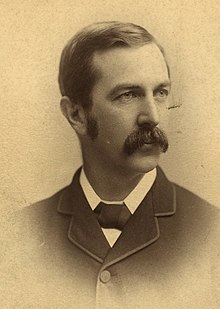Dr. Edward Willis Way(c.1847 – 28 September 1901), frequently written as "E. Willis Way", was a noted medical doctor and surgeon in the early days of thecolony of South Australia.

Early life and education
editWay was a son of Rev.James Wayof theBible Christian Church,and brother ofSir Samuel Way,the noted jurist, and left forAdelaidewith his parents as a young child in theAnna Maria,arriving on 14 November 1850.[1]He was educated atAEIandSt. Peter's Collegebefore studying medicine atGuy's Hospitaland theUniversity of Edinburgh.[2]
Career
editHe returned to Adelaide and soon had a lucrative practice, though pursuit of wealth was not his prime concern.[3]He was Medical Officer to the Stockade (laterYatala Labour Prison) and Health Officer to theAdelaide City Council.[4]He established his own private hospital (previously Miss Baker's Private Hospital?) inNorth Adelaide.[citation needed]He lectured inobstetricsandgynaecologyat theUniversity of Adelaide.[5]
Much of his work at theNorth Adelaide Hospitalwas taken over by James Alexander Greer Hamilton (c.1853 – 8 October 1925[6]).[7]
Way also worked at thePrivate Hospital, Wakefield Street[8]and was Honorary Gynaecologist (and Physician) at theAdelaide Hospital.He was President of theSouth Australianbranch of theBritish Medical Associationfrom 1892 to 1893.[5]
Hospital controversy
editAdelaide Hospital in the last decade of the 19th century was a dysfunctional workplace, riven with jealousies and intrigues. In 1895 aRoyal Commissionwas called to investigate a promotion seen as favouritism, and the sacking of nurseGraham.[9]Around the beginning of 1896 the Board of Adelaide Hospital, of which Way was a member, made changes in the nursing structure,[10]one of the results being the promotion of Bessie Way, one of his daughters, to the position of Charge Nurse. PremierKingston,who bore an antagonism towards Way, accused him ofnepotism.[11]Nurse Way avoided the disagreeable situation by accepting a somewhat better position with the Kalgoorlie Hospital inWestern Australia.[12]Kalgoorliebecame the home of most, if not all, of his children.[citation needed]
Family
editHe was brother ofSir Samuel Wayand close friend of brother-in-law theHon. Dr. Allan Campbell.
He and his wife (c.1850 – 20 October 1906) had a home onNorth Terrace, Adelaideand another residence atStrangways Terrace,North Adelaide. Among their children were:
- Inman Way, Resident Medical Officer, of Kalgoorlie Hospital.
- Eldest daughter Florence Jane Elizabeth "Bessie" Way (died 14 July 1949) married Arthur Vernon Harvey (1864 – 30 August 1901), mining investor of Kalgoorlie, and son ofArthur Harveyon 7 October 1896. He was killed atDevondale, South Africain the South African War.[13]She married again, to Captain C(harles) Stanley Tratman of the 22nd Battalion, 8th Brigade,1st AIF,on 19 October 1915. She was first matron of Kalgoorlie Hospital, then its secretary, later matron of Ru Rua Hospital, North Adelaide.[14]
- Second daughter Kate Isabel married William Arthur Irwin (ca.1860 – 12 October 1939), surveyor, on 18 April 1898, lived at South Perth.
- Third daughter Grace Mary "Gracie" Way married Henry Offley Irwin M.B., B.S. (ca.1871 – 31 January 1939) on 14 March 1898, lived at Boulder, Western Australia.
- Youngest daughter Marian married general practitioner (Arthur) Waldo Connelly (died 27 July 1946), ofBoulder, Western Australiaon 4 March 1903; later ofCamberwell, Victoria.[15]
Death
editHe died suddenly on 28 September 1901, while performing a surgical operation at his private hospital, and was buried at the North Road Cemetery. A parliamentary debate on matters critical of Chief Justice Way was postponed out of respect for the loss of his brother.[16]
References
edit- ^"Churches and Church Affairs".The Register.Adelaide. 5 April 1924. p. 6.Retrieved21 September2014– via National Library of Australia.
- ^"Dr. E. Willis Way".South Australian Register.Adelaide. 6 July 1899. p. 5.Retrieved21 September2014– via National Library of Australia.
- ^"Correspondence (M. S. Harper)".The Advertiser.Adelaide. 3 October 1901. p. 6.Retrieved21 September2014– via National Library of Australia.
- ^"Death of Dr. E. W. Way".The Register.Adelaide. 30 September 1901. p. 5.Retrieved17 September2014– via National Library of Australia.
- ^abAMA Historical Committee."Past Presidents of South Australian Branch of the BMA and AMA (SA) 1879-"(PDF).Australian Medical Association.Archived fromthe original(PDF)on 13 May 2021.Retrieved13 May2021.
- ^AMA Historical Committee."Past Presidents of South Australian Branch of the BMA and AMA (SA) 1879-"(PDF).Australian Medical Association.Archived fromthe original(PDF)on 13 May 2021.Retrieved13 May2021.
- ^"Death of Dr. J A G Hamilton".The Advertiser.Adelaide. 9 October 1925. p. 13.Retrieved21 September2014– via National Library of Australia.
- ^Nursing in South Australia: First Hundred Years 1837-1937.Adelaide: South Australian Trained Nurses’ Centenary Committee. February 1938.
- ^"The Adelaide Hospital".The Advertiser (Adelaide).South Australia. 10 April 1895. p. 7.Retrieved10 October2018– via National Library of Australia.
- ^"A Ministerial Crisis".South Australian Register.Adelaide. 15 February 1896. p. 5.Retrieved21 September2014– via National Library of Australia.
- ^"The Adelaide Hospital—The Premier and Miss Way's Appointments".South Australian Register.Adelaide. 29 July 1896. p. 6.Retrieved21 September2014– via National Library of Australia.
- ^"Adelaide Hospital. Another Disagreement".The Advertiser.Adelaide. 5 March 1896. p. 5.Retrieved21 September2014– via National Library of Australia.
- ^"Personal".The Advertiser.Adelaide. 1 October 1901. p. 5.Retrieved5 September2015– via National Library of Australia.
- ^"Items of News".Kalgoorlie Miner.WA. 19 July 1949. p. 4.Retrieved21 September2014– via National Library of Australia.
- ^"Personal".Kalgoorlie Miner.WA. 29 July 1946. p. 2.Retrieved22 September2014– via National Library of Australia.
- ^"The Prisoner Andersen".The Advertiser.Adelaide. 3 October 1901. p. 8.Retrieved21 September2014– via National Library of Australia.